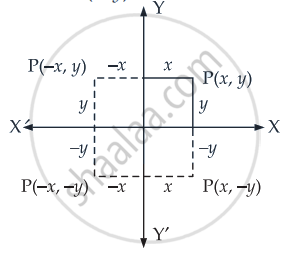Advertisements
Advertisements
Question
If the sum of the distances of a moving point in a plane from the axes is 1, then find the locus of the point.
Solution
Let coordinates of a moving point P be (x, y).
Given that the sum of the distances from the axes to the point is always 1
∴ |x| + |y| = 1
⇒ x + y = 1
⇒ – x – y = 1
⇒ – x + y = 1
⇒ x – y = 1
Hence, these equations gives us the locus of the point P which is a square.
APPEARS IN
RELATED QUESTIONS
Find the distance of the point (–1, 1) from the line 12(x + 6) = 5(y – 2).
Find the points on the x-axis, whose distances from the `x/3 +y/4 = 1` are 4 units.
Find the distance between parallel lines:
15x + 8y – 34 = 0 and 15x + 8y + 31 = 0
Find the distance between parallel lines l (x + y) + p = 0 and l (x + y) – r = 0
What are the points on the y-axis whose distance from the line `x/3 + y/4 = 1` is 4 units.
Find the equation of the line parallel to y-axis and drawn through the point of intersection of the lines x– 7y + 5 = 0 and 3x + y = 0.
A ray of light passing through the point (1, 2) reflects on the x-axis at point A and the reflected ray passes through the point (5, 3). Find the coordinates of A.
A line passes through a point A (1, 2) and makes an angle of 60° with the x-axis and intersects the line x + y = 6 at the point P. Find AP.
A line a drawn through A (4, −1) parallel to the line 3x − 4y + 1 = 0. Find the coordinates of the two points on this line which are at a distance of 5 units from A.
Find the distance of the point (2, 3) from the line 2x − 3y + 9 = 0 measured along a line making an angle of 45° with the x-axis.
Find the distance of the point (3, 5) from the line 2x + 3y = 14 measured parallel to a line having slope 1/2.
Show that the perpendiculars let fall from any point on the straight line 2x + 11y − 5 = 0 upon the two straight lines 24x + 7y = 20 and 4x − 3y − 2 = 0 are equal to each other.
Find the distance of the point of intersection of the lines 2x + 3y = 21 and 3x − 4y + 11 = 0 from the line 8x + 6y + 5 = 0.
What are the points on X-axis whose perpendicular distance from the straight line \[\frac{x}{a} + \frac{y}{b} = 1\] is a ?
Show that the product of perpendiculars on the line \[\frac{x}{a} \cos \theta + \frac{y}{b} \sin \theta = 1\] from the points \[( \pm \sqrt{a^2 - b^2}, 0) \text { is }b^2 .\]
What are the points on y-axis whose distance from the line \[\frac{x}{3} + \frac{y}{4} = 1\] is 4 units?
If sum of perpendicular distances of a variable point P (x, y) from the lines x + y − 5 = 0 and 3x − 2y + 7 = 0 is always 10. Show that P must move on a line.
Determine the distance between the pair of parallel lines:
8x + 15y − 34 = 0 and 8x + 15y + 31 = 0
Determine the distance between the pair of parallel lines:
y = mx + c and y = mx + d
If the lines x + ay + a = 0, bx + y + b = 0 and cx + cy + 1 = 0 are concurrent, then write the value of 2abc − ab − bc − ca.
L is a variable line such that the algebraic sum of the distances of the points (1, 1), (2, 0) and (0, 2) from the line is equal to zero. The line L will always pass through
Area of the triangle formed by the points \[\left( (a + 3)(a + 4), a + 3 \right), \left( (a + 2)(a + 3), (a + 2) \right) \text { and } \left( (a + 1)(a + 2), (a + 1) \right)\]
The line segment joining the points (−3, −4) and (1, −2) is divided by y-axis in the ratio
The shortest distance between the lines
`bar"r" = (hat"i" + 2hat"j" + hat"k") + lambda (hat"i" - hat"j" + hat"k")` and
`bar"r" = (2hat"i" - hat"j" - hat"k") + mu(2hat"i" + hat"j" + 2hat"k")` is
If P(α, β) be a point on the line 3x + y = 0 such that the point P and the point Q(1, 1) lie on either side of the line 3x = 4y + 8, then _______.
Find the distance between the lines 3x + 4y = 9 and 6x + 8y = 15.
A point moves such that its distance from the point (4, 0) is half that of its distance from the line x = 16. The locus of the point is ______.
A point moves so that square of its distance from the point (3, –2) is numerically equal to its distance from the line 5x – 12y = 3. The equation of its locus is ______.
